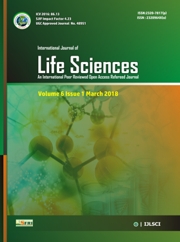OVERVIEW
Volume 7 |Issue 1| January-Febrary 2019 First published: 28 February 2019
Breath taking stunning life under frozen wave of Antarctica
Gupta Swaroopa Rani N (Ph.D.)
Department of Chemistry, Brijlal Biyani Science College Amravati, Maharashtra, India
*Correspondence author’s Email: Email: swargupta@yahoo.com
Abstract
Keywords:Antartic region, Penguins, Icefish, Toothfish, Antarctic hair grass (Deschampsia antarctica), Antarctic pearlwort (Colobanthus quitensis), Blue Ice.
Editor: Dr.Arvind Chavhan
Cite this article as:
Gupta Swaroopa Rani N. Breath taking stunning life under frozen wave of Antarctica. Int. Res. Journal of Science & Engineering, 2019, 7 (2): 17-28.
References
1. Scientific Committee on Antarctic Research website". SCAR. Archived from the original on 2013-12-14.
2. https://en.wikipedia.org/wiki/Antarctic#/media/File:Antarctic-Overview-Map-EN.tif
3. https://en.wikipedia.org/wiki/Antarctic_Plate#/media/File:AntarcticPlate.png
4. https://en.wikipedia.org/wiki/Lists_of_places_in_Antarctica#/media/File:Antarctica.svg
5. IAATO tourist statistics 2007/08
6. Antarctic Wildlife". Natural Environment Research Council - British Antarctic Survey. Archived from the original on 2012-10-05. Retrieved 2012-11-20.
7. Vanessa Woods (2011-10-14). "Antarctic wildlife". Commonwealth Scientific and Industrial Research Organisation. Archived from the original on 2013-12-14. Retrieved 2012-11-20.
8. Fox, Douglas (August 20, 2014). "Lakes under the ice: Antarctica's secret garden". Nature. 512: 244–246. Bibcode:2014Natur.512..244F. doi:10.1038/512244a. PMID 25143097. Retrieved August 21, 2014.
9. Jump up^ Mack, Eric (August 20, 2014). "Life Confirmed Under Antarctic Ice; Is Space Next?". Forbes. Retrieved August 21, 2014.
10. https://en.wikipedia.org/wiki/Leopard_seal#/media/File:Antarctic_Sound-2016-Brown_Bluff%E2%80%93Leopard_seal_(Hydrurga_leptonyx)_04.jpg
11. https://en.wikipedia.org/wiki/Wildlife_of_Antarctica#/media/File:Kaiserpinguine_mit_Jungen.jpg
12. https://en.wikipedia.org/wiki/Antarctica#/media/File:Adelie_Penguins_on_iceberg.jpg
13. https://en.wikipedia.org/wiki/Wildlife_of_Antarctica#/media/File:Antarctic_krill_(Euphausia_superba).jpg
14. Australian Antarctic Division. "Fish". Government of Australia. Archived from the original on 19 March 2013. Retrieved 5 April 2013.
15. Cheng, C.-H.C.; L. Chen; T.J. Near; Y. Jin (2003). "Functional Antifreeze Glycoprotein Genes in Temperate-Water New Zealand Nototheniid Fish Infer an Antarctic Evolutionary Origin". Mol. Biol. Evol. 20 (11): 1897–1908. doi:10.1093/molbev/msg208.
16. https://en.wikipedia.org/wiki/Wildlife_of_Antarctica#/media/File:Icefishuk.jpg
17. Jung, A.; P. Johnson; J.T. Eastman; A.L. Devries (1995). "Protein content and freezing avoidance properties of the subdermal extracellular matrix and serum of the Antarctic snailfish, Paraliparis devriesi". Fish Physiol Biochem. 14 (1): 71–80. doi:10.1007/BF00004292.
18. Stauffer, L.B. (12 January 2011). "Researchers show how one gene becomes two (with different functions)". Illinois News Bureau. Retrieved 29 December 2017.
19. Jump up^ Froese, Rainer, and Daniel Pauly, eds. (2017). Species of Dissostichus in FishBase. December 2017 version.
20. https://en.wikipedia.org/wiki/Antarctic_toothfish#/media/File:Dmawsoni_Head_shot.jpg
21. Froese, Rainer and Pauly, Daniel, eds. (2017). "Pleuragramma antarcticum" in FishBase. December 2017 version.
22. https://en.wikipedia.org/wiki/Wildlife_of_Antarctica#/media/File:Underwater_mcmurdo_sound.jpg
23. Lee, Youne-Ho (2004). "Molecular phylogeny and divergence time of the Antarctic sea urchin (Sterechinus neumayeri) in relation to the South American sea urchins". Antarctic Science. 16 (1): 29–36. doi:10.1017/S0954102004001786.
24. Australian Antarctic Division. "Seabed (benthic) communities". Government of Australia. Archived from the original on 19 March 2013. Retrieved 8 April 2013.
25. Alexis M. Janosik, Alexis M.; A.R. Mahon; K.H. Halanych (2011). "Evolutionary history of Southern Ocean Odontaster sea star species (Odontasteridae; Asteroidea)". Polar Biology. 34 (4): 575–586. doi:10.1007/s00300-010-0916-7.
26. Dearborn, John H.; Edwards, Kelly C.; Fratt, David B. (1991). "Diet, feeding behavior, and surface morphology of the multi-armed Antarctic sea star Labidiaster annulatus (Echinodermata: Asteroidea)". Marine Ecology Progress Series. 77: 65–84. doi:10.3354/meps077065.
27. Plants of Antarctica". Natural Environment Research Council - British Antarctic Survey. Archived from the original on 2011-06-07. Retrieved 2012-11-20.
28. https://en.wikipedia.org/wiki/Deschampsia_antarctica#/media/File:Deschampsia_antarctica.jpg
29. https://en.wikipedia.org/wiki/Colobanthus_quitensis#/media/File:Antarctic_Pearlwort.jpg
30. Braun, Charles L.; Smirnov, Sergei N. (August 1993). "Why Is Water Blue?". J. Chem. Edu., 1993, 70(8), 612. Dartmouth College. Retrieved 2013-12-22.
31. Harvey, Eveline (14 January 2011). "NZ blue ice sighting an unexpected treat for tourists". The New Zealand Herald. Retrieved 21 September 2011.
32. https://i.pinimg.com/originals/1c/50/35/1c5035a16d2c56d849a3ef0aedb299d0.jpg
33. https://en.wikipedia.org/wiki/Blue_ice_(glacial)#/media/File:JoekullsarlonBlueBlockOfIce.jpg
34. https://en.wikipedia.org/wiki/Blue_ice_(glacial)#/media/File:Antarctic_blueice_hg.png
35. Laybourn-Parry, Johanna; Wadham, Jemma (2014-08-14). Antarctic Lakes. OUP Oxford. ISBN 9780191649325.
36. https://www.google.co.in/search?q=The+%27frozen+wave%27:+Stunning+50ft+blue+ice+monolith+captured+in+the+Antarctic&tbm=isch&tbo=u&source=univ&sa=X&ved=2ahUKEwjngs6JkozbAhWXbysKHbVeCYkQ7Al6BAgBEDk&biw=1280&bih=653#imgrc=A_12Z-zMQpfawM:
37. http://www.dailymail.co.uk/news/article-2238603/Frozen-waves-blue-ice-photographed-Tony-Travouillon.html
38. https://www.google.co.in/search?q=The+%27frozen+wave%27:+Stunning+50ft+blue+ice+monolith+captured+in+the+Antarctic&tbm=isch&tbo=u&source=univ&sa=X&ved=2ahUKEwjngs6JkozbAhWXbysKHbVeCYkQ7Al6BAgBEDk&biw=1280&bih=653#imgrc=3bsEv8o6i1KZbM:
39. Antarctic icebergs and frozen waves, January 23rd, 2009 (07:21 am), Tags: 2008, ice, image, photobucket, ppw. https://users.livejournal.com/-forward-march-/269076.html
40. https://www.google.co.in/search?q=The+%27frozen+wave%27:+Stunning+50ft+blue+ice+monolith+captured+in+the+Antarctic&tbm=isch&tbo=u&source=univ&sa=X&ved=2ahUKEwjngs6JkozbAhWXbysKHbVeCYkQ7Al6BAgBEDk&biw=1280&bih=653#imgrc=oowupyVrg1YrFM:
41. https://www.google.co.in/search?q=striped+icebergs+antarctica&tbm=isch&source=iu&ictx=1&fir=wBfmZyBb6vTt3M%253A%252CqQxnXvSJQMB7GM%252C_&usg=__OjoZb7kf8S3bw1syzRNym_sdrwM%3D&sa=X&ved=2ahUKEwi2x9DylIzbAhUTU30KHQ8uA6sQ9QEwBnoECAEQPQ#imgrc=wBfmZyBb6vTt3M:

